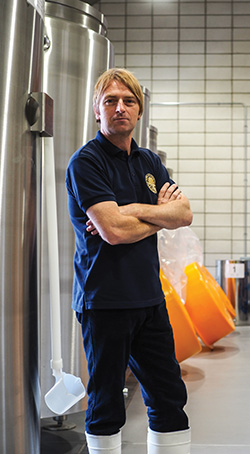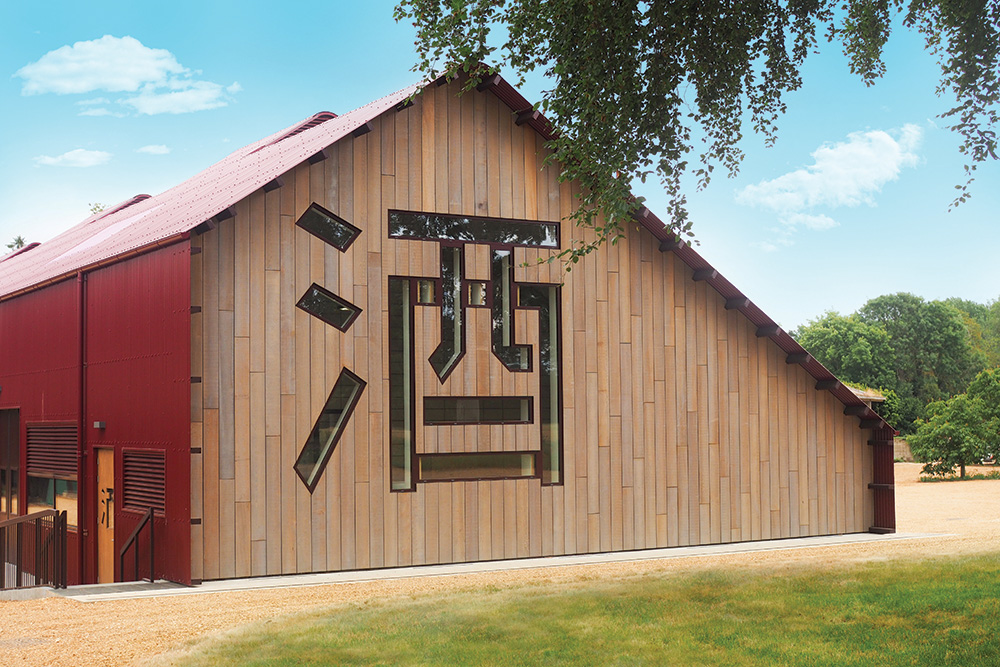Alex Rushmer visits Fordham’s new sake brewery, the first of its kind in the UK
There was a noticeable yin and yang feeling to my two visits to Dojima Sake Brewery, just outside Fordham. My first trip occurred back in March; the tail end of the ‘Beast from the East’ had covered the Fens in snow. An aggressive wind whipped over the landscape and the unfinished grounds and house of Fordham Abbey appeared empty and barren. The brewery itself – the very first purpose-built sake brewery in the UK – was unfinished, and the impressive tanks in the fermenting room were covered in a thin layer of dust. After overseeing the project from inception, head brewer Tony Mitchell was keen to get on with the task of actually making sake, rather than helping to manage the build.

Tony’s quiet enthusiasm for a product virtually unknown in this country is engaging. His knowledge is astounding – gleaned from stints working in Japan for generations of brewers that go back centuries. Walking me through the space, he explained the process: tiny variations in time, temperature, atmospheric pressure, PH levels, water quality and, of course, rice, have a profound impact on the final product. He clearly had serious ambitions for the eventual quality of the product he hoped to make.
Fast-forward several months to my second visit and there are plenty of changes. The dark red modern brewery building is complete, with a huge and stunning window that reads ‘sake’ in Japanese script. It is a wonderful contrast to the Georgian splendour of the 18th century house. And now, rather than being coated in blinding white snow, the lawns are parched, dry and yellowing from the intense sun of the heatwave that the country is experiencing. More importantly, Tony (right) has finally been able to make a few small batches of a unique product: genuine British sake. Another test brew is slowly fermenting in a tank, jacketed in foam mats stuffed with ice to protect against the heat outside.
“This stage is about experimentation. I’m aware that this is an ongoing process and I’m keen to get it right,” he says. “Ultimately, we want to bring a little corner of Osaka to the Cambridgeshire countryside.” Judging by the ambition, location and the relentless pursuit of perfecting the sake itself, the team at Dojima will have little trouble with that.
This is a serious project. The ideas and investment have come from the Hashimoto family who have been brewing sake in Ishikawa Province, about 200km north of Kyoto, since the 1800s. They broke ground on the project in autumn 2016 and although there is now sake in the tanks, this is only the start. Space has been made for a shop, cafe and visitors’ centre to open within the next six months. Noriko Tomioka, the brewery’s general manager and estate manager, reveals more plans for the future. “We hope that this will be our restaurant space,” she tells me, pointing out a series of old barns, currently home to a kiln being used by a master Japanese craftsman who is handcrafting a series of unique ceramics to sell in the shop.
“a few small batches of a unique product… British sake”
Of course, the success of the project hinges on the quality of the product. It is, unsurprisingly, sensational. The rice is imported directly from Japan but the water (the second most important ingredient) comes straight out of the earth from a natural spring within the Abbey grounds and lends the sake a wonderful sense of place and purpose. Although I’ve drunk sake before, and used it as a food pairing for my menus, this was the first time I was able to taste one so fresh and unpasteurised, known as nama sake, which translates to ‘raw’. The flavour was clean, refreshing, complex and with a noticeable rice flavour on the finish. It was utterly delicious – and this merely a small test brew.
This is an artisanal product. The plan is to produce about 10,000 bottles, in a range of styles, by the end of the year. “It’s a physical process; very involved mentally and physically,’ says Tony. “When you’re making the koji (see right) you need to check on it every three or four hours, day and night. The process of mixing, stirring and pressing the sake is tiring. It’s a hard job.” But as we sit in his office, sipping sake from delicate cups, he smiles. It really is worth the effort. l
Dojima Sake Brewery can be found on Instagram @dojimasake and is open for tours by appointment only. To book, please contact [email protected]
Sake styles
Some sake is fortified with alcohol. Dojima is focusing on the Junmai style, with no extra alcohol. It is made with ‘polished’ rice, rice with the outer layers removed.
Junmai: a pure rice wine, usually made with rice polished to 70{b486c5a37ab2d325d17e17d701cb2567b1ecd1814e8ceb33effa2a4f1f171d46}
Junmai-Ginjo: sake made with rice that has been polished to 60{b486c5a37ab2d325d17e17d701cb2567b1ecd1814e8ceb33effa2a4f1f171d46}
Junmai-Daiginjo: sake made with rice that has been polished to 50{b486c5a37ab2d325d17e17d701cb2567b1ecd1814e8ceb33effa2a4f1f171d46}
Namazake: an unfiltered, unpasteurised sake generally unavailable outside of Japan
How sake is made
Sake, often called rice wine, is closer to beer in the way it is made. Polished rice grains are soaked, steamed and then inoculated with a culture to make koji (which breaks down carbohydrates into sugars), and then left to ferment. The process is used in Japanese cuisine, such as in soy sauce and tofu making. There are a number of fermentation stages, altogether taking several weeks, with repeated additions of koji, steamed rice and water. Once the fermentation is complete the mixture is pressed to separate the liquid and solids. The sake is bottled and, usually, pasteurised. It is best drunk within a year of being bottled and, once opened, keeps for about a week in a fridge.

